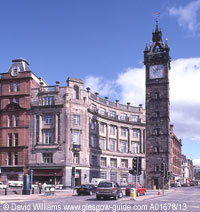1625-7, John Boyd
The seven-storey Tolbooth Steeple is Glasgow Cross`s most important feature and it is topped by a clock and a stone crown. This was once part of a much larger building, the Tolbooth, which provided accommodation for the Town Clerk`s office, the council hall and the city prison. The debtors` prison had a steady stream of inmates who elected their own `provost` and generally ran the place like an exclusive club. They produced their own regulations, including one from 1789 which stated: `It is firmly and irrevocably agreed upon that the members of these rooms shall not permit the jailor or turnkeys to force any person or persons into their apartments, who are thought unworthy of being admitted.` There was even a rule about celebrating freedom: `Every member, when liberated, shall treat his fellow-prisoners with one shilling`s worth of what liquor they think proper.`
The Tolbooth provided the backdrop to many of the city`s dramas and it was here
that witches, thieves and murderers were summarily dealt with, by hanging if necessary.
It also had a special platform from which proclamations were read, important in
the days before general literacy. The paved area (the `plainstanes`) in front
of the Tolbooth was the `in place` to be seen and here the rich paraded in their
finery, particularly the Tobacco Lords, attired in red cloaks and sporting gold-topped
canes.
Glasgow Cross developed as a communications hub, with stagecoaches from Edinburgh and London bringing visitors and news, and a reading room in the Tolbooth providing newspapers. However, as the city expanded and moved westwards, the Tolbooth was abandoned and eventually demolished, leaving the steeple as an isolated reminder of bygone days. This tragic loss of an important building was the result of the work of The City Improvement Trust which had the unenviable task of ridding the city of its slums.
This article is based on the guidebook "The Glasgow Guide".

The Tolbooth Steeple stands on a small "traffic island" and dominates Glasgow Cross.
The original Tolbooth stood to the left of the Tolbooth Steeple.